

Last Friday, I was to visit my mother-in-law in hospital and leave her a few things she had asked for (she has broken her leg), so I thought I'd make the trip into town before the shops closed, to pick up
some more pastry for the final round of pie-making for the winter -
kalitsounia. What a blessing it was to go to the hospital later than I was expected - half an hour before I arrived, a group of thugs had walked into the emergency department, taking advantage of the lax security, and went in search of another thug who they had just stabbed and had been taken into hospital by his relatives. They brought crowbars and knives with them, and there was no stopping them. In all, another four people (praise the Lord, not hospital staff or patients and their carers) were stabbed or beaten and had to be dealt with - in an understaffed hospital, where doctors do 12-hour shifts on a daily basis, and nurses never get the leave they owed when they want or need it. As I reported in a
previous post, Hania's turning uglier by the day. It's a pity those thugs didn't have anything better to do; had they known that spinach is in plentiful supply at the moment in Crete, they might've been making kalitsounia instead of beating each other up. February is usually a cold month in Greece, colder than Christmas, and this winter has been no exception. But February is also the month for spinach, and pie-baking will take your mind away from the evils of humanity and the bad weather.


If it's growing in your garden, you'll need to think up of ways to use it or preserve it to make sure you don't throw away your excess crop. I'd love to be able to give some away to friends, but our spinach grows quite small (my mother-in-law doesn't believe in fertiliser), so there's only just enough for us. The trouble is that it seems to grow altogether, and I have to use it up as quickly as possible so that the leaves don't wilt, turn yellow or go mushy. Therefore, today, once again my kitchen became a hive of activity. A few days ago, I made
hortopites (spinach pies), then I cooked the basic sauce for
spanakorizo (spinach rice) for freezing, another day I made
tiropitakia (if you messing around with pastry and cheese, you may as well go for the works), and today I'm making
kalitsounia (from the Italian
calzone, reminding us of our Venetian origins), a small filo (phyllo) pasty made in the same way as
spanakopita but made in smaller individual servings.
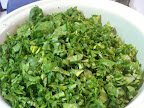
Kalitsounia are often served as part of a buffet meal at a party. I used to cook them for special nights, but now that I have children, I prefer to make and freeze them, and cook them ready for the
children's lunchboxes, or as an evening snack. If you buy the pastry (like I do), and only prepare the mixture, they are very easy to make.
My mother used to make all manner of kalitsounia in New Zealand: spinach and
mizithra pastries baked in the oven, savoury curd cheese pastries also baked in the oven, half-moon
mizithra pastries fried in the pan, and my absolute favorite, spinach and herb lenten pastries, also fried in the pan (the latter were never baked). Sometimes she bought the pastry, other times she made it herself. The times she made the most kalitsounia was just before Easter, in time for the midnight feast after the church service, and for my father's nameday at Christmas. She'd work in the fish shop, prepare our daily meals (she didn't want anyone meddling in her kitchen), prepare and cook the festive fare, then go to church, then come back home and serve it all up. She never complained, and everything got done.
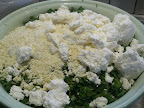
To make the kalitsounia, I prepare a mixture with exactly the same ingredients as for
spanakopita or
hortopita: spinach, mixed greens, herbs and seasonings mixed with
mizithra and seasonings, including a fistful of semolina to prevent the pastry from breaking when cooking. The same greens can be used for
spanakopita and kalitsounia; it all depends on what you have at your disposal. I have everything, so I can pick and choose.
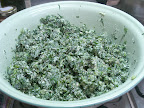
I buy my pastry in Hania. There are a few people in the area who make traditional thick filo pastry by hand. These businesses have always been family-owned, and passed down from one senior member to junior member. It's neither male nor female-oriented, but the one place I prefer is run by a man, who has his father's photo hanging on the wall (obviously the original store's owner), and he takes great pride in maintaining his father's reputation. I used to buy filo elsewhere until I discovered his, and I had clear reasons for changing supplier: the pastry is always sold in uniform sheet sizes, with a uniform thickness. This wasn't the case with the other supplier; some sheets were too thin, no side was straight, some sheets had uneven thickness.



You really must see him and his team in action, making these sheets of pastry. After the dough is mixed and kneaded, a ball of dough is patted out onto a large square wooden table. The dough is then manually stretched out to fit the whole table. The dough-stretcher - the pastry maker is a human being, not a machine - uses both hands to pull the dough to fit evenly and uniformly on the table, walking round and round the table (since the table has four corners, you could call it square dancing) as many times as needed till it is stretched to size. The pastry is then cut into manageably portable pieces, and he is covered in flour dust form head to toe. It can't be a healthy job, but it is profitable.
Kalofagas has made his own
filo pastry for spanakopita in a very similar manner to what I described above for the shop-bought one - he must have looked like a snowman after the event.


Spread the pastry sheet onto your worktop and cut it appropriately. I don't want to waste a scrap of this pastry, so I prefer to cut it into squares. I cut it with a pizza wheel. My mother made her own pastry, and always cut it into rounds using a frilled pastry wheel cutter (I think I have inherited it) and a teacup saucer as a guide. The bits that weren't used were kneaded back into the remaining dough and rolled out again. I also save the pastry scraps that can't be used, sticking them together with a dab of water, to make some kind of square shape. These days, pastry is also sold ready-cut in squares or rounds, again to the advantage of the cook. It's available in the supermarket, too, although it is a longer-life, lower-quality pastry compared to what I buy. I've tried them all.
Each square takes about a large tablespoon of filling. To stop yourself licking your fingers every time you push the mixture off the spoon, use a small fork or teaspoon to push it off. (Don't feel put off about tasting the mixture before it is cooked; it is divine. Spread it onto a piece of toast, and enjoy it for breakfast. You will never forget me once you have tried this.) Fold the pastry over diagonally for a perfect closure. You may need to dab it a bit with water - I never bother, because I press the finished square down to spread the mixture inside, and this seals it quite nicely.


To freeze the kalitsounia, I lay them all flat onto a freezer tray, but I've heard of women who lay them onto a well-oiled baking dish, making them ready for cooking as they are, adding even the brushed egg and the sesame seed on top. I haven't got enough space in my fridge for this kind of luxury, so I freeze a batch, then remove them from the tray and layer them neatly into a plastic bag - they will now be fragile, and their corners will be quite brittle, so take care when doing this if you want to serve them at a buffet. I must admit I am quite prone to such blunders. My children haven't yet told me off about it.
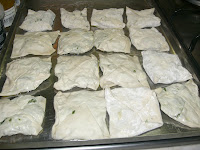


When you are ready to cook these pastries, oil a baking sheet very well, and place each pastry side by side. They shouldn't be touching each other, because they will stick together, and that won't be too pretty on the buffet table, as the edges will tear. Beat an egg in a bowl, and brush the pastry on top, sprinkling a little sesame seed on each one. Place the baking tray in a moderate oven, and cook till the pastry is browned to your liking. To lift the pastries off the tin once they are ready, I prefer a metal scraper. They may stick round the edges because of the egg spilling onto the tray. My mother's thick homemade pastry never stuck to the tin in this way. I can't understand why; convenience has its disadvantages too. Kalitsounia may stick onto the baking tray because they contain too much moisture; this is why it is very important to dry the
horta and spinach very well -
the clothesline is the best place on a dry day.
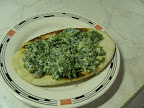
Too much mixture, not enough pastry? Better than too much pastry, not enough mixture; when you've finished the kalitsounia, spread some of the remaining mixture onto a piece of toasted sourdough bread or a pita bread, pour yourself a glass of wine, and do some introspection on your pie-making achievements. If you made
hortopites, tiropitakia and kalitsounia all in the same week, you deserve to praise yourself; you've just made two months worth of 'fast' food for your family. These pastries are very important in my family - children are not good about eating enough vegetables, but they don't mind eating these if I put them in their lunchboxes. They freeze very well, so it's easy to cook a batch and use them both as an evening snack and a lunchbox filler.
©All Rights Reserved/Organically cooked. No part of this blog may be reproduced and/or copied by any means without prior consent from Maria Verivaki.
MORE PASTRY RECIPES:
Kalitsounia fried
Marathopites
Hortopita (spanakopita)
Easter kalitsounia
Tiropitakia
Filo-pastry making
Sfakianes pites
Summer kalitsounia
Leek spiral

Maria, another in depth run down on pita making and the Cretan specialty of Katsounia which are delicious bites.
ReplyDeleteAlso, perastika to your pethera.
you mean KALI-TSOU-NIA!
ReplyDeleteMmmmm looks good!! I hardly have Greek food, so it's treat when I do. I have baklava on my list of stuff to make, but I bet you've made that enough times already lol
ReplyDeleteMaria, you are the pita queen, no doubt about it! Finishing a siege like you've described is worth more than one glass of wine... Hope your mother-in-law is getting better? Will she be getting out of the hospital soon? i hope so, though I'm sure it will be a difficult situation for you when she gets home.
ReplyDeletePS - Thanks for the pictures of filo making - they were really interesting.
ReplyDelete